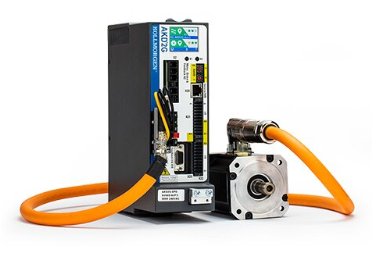Thu 27th May 2021 - How to Select a Servo Drive

A servo drive should be selected based on the specific servo motor used in the application. The motion requirements of the driven mechanism determines the voltage and current requirements of the servo motor – the key information required when selecting a servo drive. The motor specification sheet indicates the peak and continuous current requirements along with the motor voltage rating. Since many servo motors have as much as a 4 to 1 peak to continuous rating, careful consideration of the application peak torque requirements is important.
After the motor voltage and current requirements is determined, a drive can then be selected since a servo drive is rated based on its voltage and current capabilities. For a brushless DC servo drive, the input voltage determines the operating DC bus voltage to power the motor. The drive specification will consist of an input voltage and continuous and peak current ratings. It should be noted that most servo drives on the market today have a 2- or 3-times peak to continuous current rating, with the peak current available for short bursts of less than a few seconds.
Example 1
Application requirements led to a selection of a motor with a voltage rating of 240 Vac, a continuous current requirement of 3 amps and a peak current of 5 amps for acceleration. The proper drive for this application would be one with a voltage rating of 240 Vac with a continuous rating of 3 amps. A 3-amp drive will likely have a 6 or 9 amp peak current rating – well within the requirements of the application.
While matching the motor voltage and current requirements will make certain the drive has sufficient operation power, several other servo drive considerations: motion requirements, feedback options, and available communication protocols, will help determine the exact servo drive suitable for the application. Whether the motor will operate in a torque, velocity or position loop will determine the complexity of the servo drive selected. Feedback options are important since a motor may incorporate a specific feedback element that must match the drive’s ability to accept. Finally, a servo drive that is incorporated into a broader automation system may need to communicate on a specific network or fieldbus.
Example 2
A motor requires 240Vac, 8 amps peak for 1.5 seconds, and a continuous rating of 2 amps. For this application, a drive with more than 8 amps would be required to meet the peak requirements. While only 2 amps are needed for continuous operation, a 3 amp continuous drive with a 9 amp peak rating would be required. With an amplifier with a rated continuous current above the motors rating, temperature monitoring would be recommended to help prevent inadvertently overheating the motor.
Selecting a servo drive requires a strong comprehension of motion control systems and the various factors that affect their performance. A motion control expert provides the expertise necessary to navigate the complexities of the selection process. In addition, a good practice is to purchase the drive and the servo motor from the same manufacturer since their ratings are optimized to work efficiently as a system.
About the Author
This blog was a collaborative effort among a team of motion and automation experts at Kollmorgen, including engineers, customer service and design experts.
As a Gold Partner, Micromech are able to supply and provide expertise on
Kollmorgen products. Contact our sales team on
01376 333333 or
sales@micromech.co.uk for price and delivery or technical assistance.
Disclaimer
The use of this news article and images came with permission from Kollmorgen.
 A servo drive should be selected based on the specific servo motor used in the application. The motion requirements of the driven mechanism determines the voltage and current requirements of the servo motor – the key information required when selecting a servo drive. The motor specification sheet indicates the peak and continuous current requirements along with the motor voltage rating. Since many servo motors have as much as a 4 to 1 peak to continuous rating, careful consideration of the application peak torque requirements is important.
A servo drive should be selected based on the specific servo motor used in the application. The motion requirements of the driven mechanism determines the voltage and current requirements of the servo motor – the key information required when selecting a servo drive. The motor specification sheet indicates the peak and continuous current requirements along with the motor voltage rating. Since many servo motors have as much as a 4 to 1 peak to continuous rating, careful consideration of the application peak torque requirements is important.